Tarsus (Cilicia) mint, Silver Tetradrachm, 333-327 BCE
weight: 16.8g, width: 2.38cm


OBV.: Young head of Hercules, wearing lion's skin, facing right.
REV.: Zeus seated on throne with bulbous legs, facing left, feet on footstool. He holds an eagle in his outstretched right hand and a scepter in his left. Inscription ALEXANDROU (= "of Alexander") in right field. Mint mark "B" below throne. HFMA nr. 2006.010.013. Ref.: Price (1991) nr. 3000.
The far-flung campaigns of Alexander the Great, the huge empire he built, and the fact that his successors continued to mint Alexander's coins made this kind of tetradrachm the most widely circulating coin of antiquity.
The image of a young, beardless Herakles on the obverse, a reference to the direct descent of the Macedonian kings from this most popular Greek hero, is often taken as a portrait of Alexander himself. That, however, is very unlikely. Several earlier Macedonian kings had used the same design of a beardless young Herakles on their coins. The first Hellenistic king to mint coins with his own likeness was Ptolemy I of Egypt, a former general of Alexander.
On the reverse, the coin shows Zeus, the ruler of the Greek pantheon and a fitting symbol for kingship. A head of Zeus, for example, graced the obverse of the coins of Philipp II of Macedon, Alexander's father. What is unusual about the enthroned Zeus on Alexander's tetradrachms, however, is the kind of throne he sits on. A number of scholars argue that the shape of the throne's legs, in particular, is distinctly Persian. A similar depiction of an enthroned Baal of Tarsus holding an eagle had been used on the reverse of silver coins produced in Tarsus by the Persian satrap Mazaios right before Alexander conquered the city in September 333 BCE. Accordingly, some scholars believe that Alexander started his iconic silver coinage far from home in Tarsus, probably using the same artisans that cut the dies for Mazaios' coins.
If this is true, this would not only mean that Alexander waited three years after his ascension to the throne to mint his own coinage. It also means that the god on the reverse may have been read very differently, depending on the audience. Alexander's Greek soldiers probably interpreted the throning deity as their familiar Zeus, whereas the natives may have understood it as the Baal of Tarsus and may have appreciated the Greek king's apparent respect for their local god.
O.K.
Literature:
Price, M., The Coinage in the Name of Alexander the Great and Philip Arrhidaeus: A British Museum Catalogue. Zürich: Swiss Numismatic Society/London: British Museum Press, 1991.

